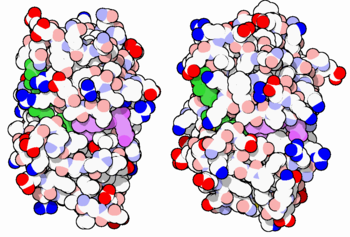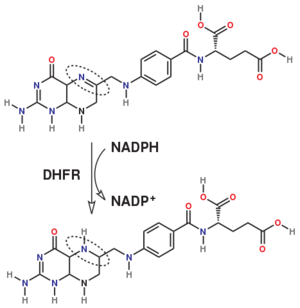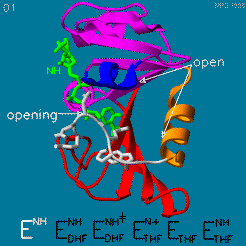Dihydrofolate reductase
From Proteopedia
| Line 21: | Line 21: | ||
DHFR forms a complex with thymidylate synthase (TS)<ref>PMID:2178951</ref>. Both enzymes participate in the biosynthesis of pyrimidine.<ref>PMID:6815178</ref> | DHFR forms a complex with thymidylate synthase (TS)<ref>PMID:2178951</ref>. Both enzymes participate in the biosynthesis of pyrimidine.<ref>PMID:6815178</ref> | ||
| - | ==Your Heading Here (maybe something like 'Structure')== | ||
<StructureSection load='' size='350' side='right' caption='' scene='82/82636/Dhfr_ternary/4'> | <StructureSection load='' size='350' side='right' caption='' scene='82/82636/Dhfr_ternary/4'> | ||
| + | __NOTOC__ | ||
== Structure and Function == | == Structure and Function == | ||
Revision as of 22:30, 6 January 2022
The enzyme dihydrofolate reductase (DHFR) occurs in all organisms and has been particularly well-studied in the bacterium Escherichia coli and in humans[1]. It catalyzes the reduction of dihydrofolate to tetrahydrofolate, with NADPH acting as hydride donor. The human enzyme is a target for developing inhibitors used in anti-cancer chemotherapies, while the bacterial enzymes are targets for developing inhibitors as antibiotics. DHFR is a model enzyme for studying the kinetics, mechanism, and inhibition of enzymatic reactions and the underlying structure and conformational dynamics.
Contents |
Sources
DHFR is found in all organisms. Some bacteria acquire resistance to DHFR inhibitors through expressing a second form of DHFR coded on a plasmid. The enzymes from E. coli and humans have similar folds, while the plasmid-encoded enzyme has an unrelated fold. In humans, DHFR is expressed in most tissues[1], and there are two genes, DHFR and DHFR2/DHFRL1, the latter targeted to mitochondria[2]. Mice and rats lack the second gene but also show DHFR activity in mitochondria[3].
Reactions catalyzed
Dihydrofolate reductase (DHFR, 1.5.1.3 [2]) is an enzyme which uses the co-factor NADPH as electron donor which converts it to NADP. It catalyzes the reduction of dihydrofolic acid (DHF) to tetrahydrofolic acid (THF). The mammalian enzymes also accept folic acid as a substrate, reducing it to THF. This allows the use of folic acid, which is easier to synthesize than DHF or THF, to fortify food.[4]. Some bacterial enzymes also accept folic acid as a substrate [5] but it acts as a competitive inhibitor in the E. coli enzyme.
The folate is a form of the essential vitamin B9. Folate is not part of our natural diet (it contains dihydrofolate and tetrahydrofolate, sometimes as a poly-glutamate conjugate) but is bioavailable and simpler to synthesize.
Relevance
DHFR forms a complex with thymidylate synthase (TS)[6]. Both enzymes participate in the biosynthesis of pyrimidine.[7]
| |||||||||||
See also
Relevance
Antifolate inhibitors like Methotrexate (MTX) which is very similar to folic acid are used in cancer therapy.
3D Structures of Dihydrofolate reductase
Dihydrofolate reductase 3D structures
Additional Resources
- For additional information, see: Cancer.
- See also Molecular Playground/DHFR.
References
Proteopedia Page Contributors and Editors (what is this?)
Michal Harel, Karsten Theis, Alexander Berchansky, Joel L. Sussman, Tzvia Selzer, Jaime Prilusky, Eric Martz, Eran Hodis, David Canner



